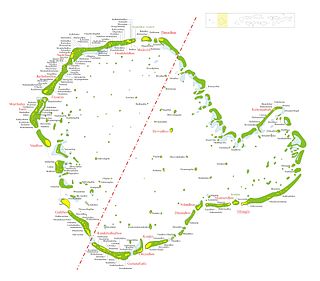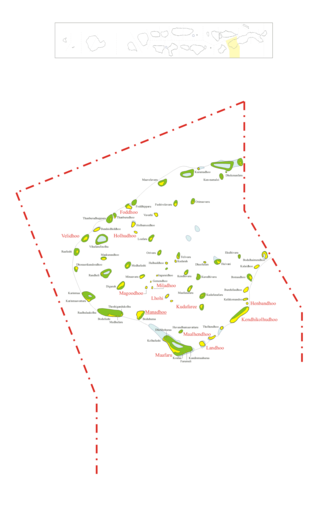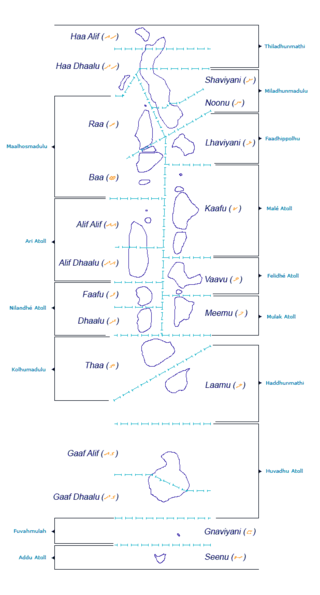
Huvadhu, Suvadive, Suvaidu or Suvadiva is the atoll with most islands in the world. The atoll is located in the Indian Ocean. It is south of the Suvadiva Channel in the Republic of Maldives with a total area of 3152 km2, of which 38.5 km2 is dry land. The atoll contains 255 islands.

Noonu Atoll is an administrative division of the Maldives corresponding to the southern section of Miladhunmadulu Atoll. The capital is Manadhoo. Total population of Noonu Atoll is around 10,000 people.
Omadhoo is one of the inhabited islands of Alif Dhaal Atoll in the Maldives.
Feridhoo is one of the inhabited islands of Ari Atoll, located on its eastern fringe. It belongs to the Alif Alif Atoll administrative division.
Himandhoo is one of the inhabited islands of the Alif Alif Atoll in the Maldives.

Thoddoo is one of the inhabited islands of Alif Alif Atoll in the Republic of Maldives.
Dhidhdhoo is the capital of Haa Alif Atoll in the Maldives. Ranked the 2nd most populated place in the north after Kulhudhuffushi City. Located in the center of the atoll, Dhidhdhoo is governed by Dhidhdhoo Island Council under the Local Government Authority. This island is famous for having the least crime rates amongst the 10 most populated islands in the nation consecutively for a number of years.

The Administrative Divisions of the Maldives refers to the various units of government that provide local government services in the Maldives. According to the Decentralization Act 2010, the administrative divisions of the Maldives would consist of atolls, islands, and cities; each administered by their own local council, under the basic terms of home rule. Geographically, the Maldives are formed by a number of natural atolls plus a few islands and isolated reefs which form a pattern from North to South. Administratively, there are currently 189 islands, 18 atolls and 4 cities in the Maldives.
Central Province was one of the seven provinces of the Maldives. The provinces were created in a decentralization attempt by the Nasheed administration in 2008. It was governed by the Minister of State for Home Affairs, Ms. Thilmeeza Hussain. Rejecting this change, the Parliament saw the abolition of the province system in 2010, through a newly enacted Decentralization Act. It consisted of Dhaalu, Faafu and Meemu Atolls. Its capital was Kudahuvadhoo. Its population was 13,442.
North Province was one of the seven short-lived provinces of the Maldives. The provinces were created in a decentralization attempt by the Nasheed administration in 2008. As of 2009, it was governed by the Minister of State for Home Affairs, Ms. Thilmeeza Hussain. Rejecting this change, the Parliament saw the abolition of the province system in 2010, through a newly enacted Decentralization Act. It consisted of Baa, Lhaviyani, Noonu and Raa Atolls. Its capital was Felivaru. Its population was 43,539.
South Province is one of the seven short-lived provinces of the Maldives. The provinces were created in a decentralization attempt by the Nasheed administration in 2008. It was governed by the Minister of State for Home Affairs, Ms. Thilmeeza Hussain. Rejecting this change, the Parliament saw the abolition of the province system in 2010, through a newly enacted Decentralization Act. It consisted of Gnaviyani Atoll and Addu City. Its capital was Hithadhoo. Its population was 25,662.
South Central Province was one of the seven short-lived provinces of the Maldives. The provinces were created in a decentralization attempt by the Nasheed administration in 2008. It was governed by the Minister of State for Home Affairs, Ms. Thilmeeza Hussain. Rejecting this change, the Parliament saw the abolition of the province system in 2010, through a newly enacted Decentralization Act. It consisted of Gaafu Alif and Gaafu Dhaalu Atolls. Its capital was Gan. Its population was 20,483.
Upper North Province was one of the seven short-lived provinces of the Maldives. The provinces were created in a decentralization attempt by the Nasheed administration in 2008. It was governed by the Minister of State for Home Affairs, Ms. Thilmeeza Hussain. Rejecting this change, the Parliament saw the abolition of the province system in 2010, through a newly enacted Decentralization Act. The province consisted of Haa Alif, Haa Dhaalu and Shaviyani Atolls. Its capital was Kulhudhuffushi. Its population was 41,672.
Upper South Province was one of the seven short-lived provinces of the Maldives. The provinces were created in a decentralization attempt by the Nasheed administration in 2008. It was governed by the Minister of State for Home Affairs, Ms. Thilmeeza Hussain. Rejecting this change, the Parliament saw the abolition of the province system in 2010, through a newly enacted Decentralization Act. It consisted of Laamu and Thaa Atolls. Its capital was Thinadhoo. Its population was 19,275.

Haa Alif Atoll is the code name based on the letters of the Maldivian alphabet commonly used to refer to the administrative division officially known as North Thiladhunmathi Atoll in the Maldives.

The Human Rights Measurement Initiative finds that Maldives is fulfilling 72.0% of what it should be fulfilling for the right to health based on its level of income. When looking at the right to health with respect to children, Maldives achieves 98.0% of what is expected based on its current income. In regards to the right to health amongst the adult population, the country achieves 99.7% of what is expected based on the nation's level of income. Maldives falls into the "very bad" category when evaluating the right to reproductive health because the nation is fulfilling only 18.2% of what the nation is expected to achieve based on the resources (income) it has available.







